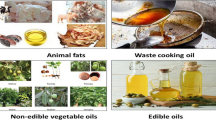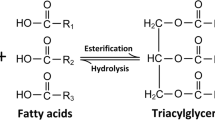The effectiveness of copolymer depressing dopants in straight-run and degraded oil fractions, namely, the 180-350°C straight-run diesel fraction, 275-400°C oil fraction, and the extract of its selective purification, vacuum gasoils, and products of delayed coking and catalytic cracking is investigated. It is shown that marine oils with improved low-temperature properties can be obtained by adding to these fractions copolymer depressing dopants in optimal concentrations.
Similar content being viewed by others
One of the most economically and technologically effective means of solving the problem of the production of marine oils with improved low-temperature properties is use of depressing dopants. Refinement of dopants was initiated abroad in the 1960s [1–3]. Copolymers of ethylene with vinyl acetate, copolymers of polyalkyl methacrylates with vinyl acetate and their analogies[2,4–9], which are known under the designations VES-238, VES-410D, deprene, paradiene-20, paradiene-25, Keroflux-5486, Dodyflow-3823, ESA-5920, ESA-4242, ESA-5922, elvax, etc., currently occupy a special place among polymer dopants that have been developed. The inclusion of other components that improve the effect of depressing dopants, for example, amides of carboxylic acids [3], olefin and maleic-anhydride copolymers [3,4], polyolefins or products of their degradation [5], alkylbenzenes [1], etc. in compositions of ethylene and vinyl acetate copolymers is rather widespread (including those under many patents).
Coploymers of different molecular mass with a different content of vinyl acetate chains are used, depending on the type of oil. For example, copolymers with a molecular mass of 2,000 and vinyl acetate chain content of 30–40 wt. % exert a maximum depressing effect on diesel fuel [4–7].
In addition to a depressing effect and a reduction in the dynamic viscosity of the fuel, ethylene copolymers with vinyl acetate may manifest protective properties when the fuel comes in contact with salt water [1–3], improve the extreme-pressure characteristics of the fuel, and increase somewhat the completeness of its combustion and cetane rating [1]. Maximum effectiveness of the copolymer dopants is achieved when the optimal molecular mass and composition of copolymers are optimal, and also when the dopant concentration is optimal for each oil product; this is the subject of investigation in this paper.
The depressing effective of copolymers was investigated for middle distillate fractions, vacuum-gasoil fractions, the straight-run 275-400°C oil fraction, and the extract of its selected purification. These fractions were obtained from a mixture of western-Siberian crudes, and have a relatively high pour point. Moreover, we investigated the following products of degraded oil fractions: kerosene-gasoil fractions of delayed coking (KGF DC) and catalytic cracking (KGF CC), as well as light gasoil of delayed coking (LGDC, 180-360°C), and light gasoil of catalytic cracking (LGCC, 180-360°C).
The high pour point of the vacuum distillates is explained by their elevated solid-paraffin content. The straight-run diesel fraction, LGDC, and LGCC, contain a comparatively small amount of solid paraffins. The straight-run 275-400°C oil fraction and its extract occupy an intermediate position with respect to solid-paraffin content. Physicochemical characteristics of the middle-distillate fractions, KGF DC, and KGF CC, and the straight-run 275-400°C oil fraction and its extract are presented in Table 1, while characteristics of the vacuum gasoils are arrayed in Table 2.
All distillates investigated are characterized by a relatively high concentration of sulfur, and only in the extract and KGF DC did its content exceed 2 wt. %. Based on all remaining indicators, these distillates exhibit a significant reserve for use as basic components of low- and high-viscosity marine oils.
We investigated depressing dopants A and B, which were obtained from an experimental plant operated by the JSC VNII NP. These dopants apply to ethylene copolymers with vinyl acetate. Dopant A (vinyl acetate-chain content of 30–40 wt. %, and molecular mass of about 2,000) was produced at a temperature of 100-150°C and pressure of up to 150 MPa. Dopant B is a mixture of copolymers obtained under various regimes.
The responsiveness of the straight-run diesel fraction, LGCC, and LGDC to the depressing dopants A and B was investigated. Figure 1, a and b shows the dependence of the depressing properties of dopants A and B on their concentration in the straight-run diesel fraction, LGDC, and LGCC. It is apparent that the effectiveness of dopant A improves with its increasing concentration. The maximum depressing effect is achieved when its concentration is 0.25-0.5 wt. %. In that case, the pour point of the straight-run fraction is diminished by 12°C, that of the LGDC by 6°, and that of the LGCC by 22°. Addition of depressing agent A in the amount of more than 0.5 wt. % does not lead to further lowering of the pour points of the fractions under consideration; this may be a result of complete saturation of the adsorptive layer of the dopant on the surface of the paraffin crystals.
The change in pour point on introduction of dopant B is similar to the results obtained for dopant A: maximum depression of the pour point is characteristic of the LGCC (24°), and minimum depression for the LGDC (10°). It can be concluded that the LGCC and the straight-run diesel fraction are most responsive, while the LGDC is least responsive to dopants A and B.
We then investigated the responsiveness of the KGF DC and KGF CC to the dopants under investigation. These fractions differ in terms of fractional and hydrocarbon composition. The solid-paraffin content is nearly the same. The KGF DC contains more heavy aromatic hydrocarbons and resins than the KGF CC.
Figure 2, a and b show the dependences of the depressing properties of dopants A and B on their concentration in the KGF DC, KGF CC, oil fraction, and extract. The addition of 0.25-0.5 wt. % of dopant A lowers the pour point of the KGF DC from 10 to −26°C, and that of the KGF CC from −6°C to −31°C. A reduction in the pour point of the KGF DC from 10 to −24°C and the KGF CC from −6° to −34°C is observed when 0.1 wt. % of dopant B is added to these oils.
The opposite effect is observed when the dopants are introduced to the extract: a similar lowering of the pour point (from −4 to −38°C) is achieved when the concentration of dopant B is doubled (0.5%) as compared with dopant A (0.25%). Maximum lowering of the pour point of the oil fraction (to −24°) is achieved when dopant B is added in the amount of 0.5 wt. %.
The influence exerted by the concentration of dopants A and B on the pour points of the vacuum-gasoil fractions were investigated in the next stage of the investigation (Fig. 3, a and b). These fractions are characterized by relatively high pour points, viscosities, and solid-paraffin contents. As is apparent, the addition of depressing agent A is most effective when introduced in the amount of 0.1-0.25 wt. % to the 350-500ϵC and 350-540°C fractions, and in a substantially greater amount (0.5-1 wt. %) to the 350-580°C fraction. Further addition of dopant A to the vacuum-gasoil fractions does not yield a perceptible result. Obviously, the effectiveness of dopant A diminishes with increasing viscosity of the fraction being modified.
Dopant B has a similar effect on pour-point depression of the vacuum gasoils; here, however, a larger amount of this dopant is required as compared with depressing agent A.
To depress the pour point by the same amount as in the case of the application of dopant A, it was necessary to introduce 0.25-0.5 wt. % of dopant B to the 350-500°C fraction, and no less than 1 wt. % to the 350-580°C fraction. On the other hand, a similar maximum pour-point depression of the 350-450°C fraction is achieved when the concentrations of the A and B dopants is the same.
On the whole, the depression in the pour point for the vacuum-gasoil fractions investigated ranges from 22 to 26°. These experiments indicated that the responsiveness of the fractions in questions to dopants A and B will depend primarily on their content of paraffin hydrocarbons. The effectiveness of the depressing agents will also depend to a significant degree on the content of other groups of hydrocarbons in the fractions under consideration. It is apparent from Table 2 that the content of heavy aromatic hydrocarbons and resins in these fractions increases with their increasing EP, whereupon the content of solid paraffins is little diminished, but their melting point is elevated; this will make itself felt negatively on the effectiveness of the dopants.
Data on maximum pour-point depression of all the oils investigated for introduction of dopants A and B are codified in Table 3.
The high efficiency of the copolymer dopants investigated will enable us to recommend them for production of low-congealing marine oils. Use of these dopants will permit significant lowering of the pour point of marine oils, and thereby a reduction in the consumption of diesel fuel for their preparation, improvement not only in the operational, but also ecological characteristics of the oils and the combustion process, and protection of the diesel engine from wear.
References
A. G. Folomeeva, D. O. Kondrashev, N. K. Kondrasheva et al., In: Theses of Papers Presented at the Sixteenth International Scientific-Technical Conference “Reagents 2003” [in Russian], Ufa (2003), p. 47.
A. G. Folomeeva and D. O. Kondrashev, In: Theses of Papers Presented at the Fourth Congress of Oil and Gas Producers of Russia [in Russian], Ufa (2003), pp. 122–123.
S. T. Bashkatova, V. M. Rossinskii, E. B. Kotin et al., Khim. Tekhnol. Topl. Masel, No. 9, 38 (1993).
T. N. Mitusova, E. V. Polina, and M. V. Kalinina, Modern Diesel Fuels and Their Additives [in Russian], Tekhnika, Moscow (2002).
T. N. Mitusova, E. E. Safonova, G. A. Bragina et al., Nefteperer. Neftekhim., No. 1, 12–14 (2006).
S. A. Akhmetov, Motor-Fuel Production [in Russian], UGNTU, Ufa (1990).
D. O. Kondrashev, A. G. Folomeeva, and N. K. Kondrasheva, Bashkir. Khim. Zh., 9, No. 4, 42–44 (2002).
A. M. Danilov, Application of Additives to Fuels [Russian translation], Mir , Moscow (2005).
A. M. Danilov, Application of Additives to Fuels. Handbook [in Russian], Khimizdat, Moscow (2010).
Author information
Authors and Affiliations
Additional information
Translated from Khimiya i Tekhnologiya Topliv i Masel, No. 1, pp. 27 – 30, January – February, 2013.
Rights and permissions
About this article
Cite this article
Kondrasheva, N.K. Production of Marine-Oil Components with Improved Low-Temperature Properties. Chem Technol Fuels Oils 49, 41–47 (2013). https://doi.org/10.1007/s10553-013-0409-9
Published:
Issue Date:
DOI: https://doi.org/10.1007/s10553-013-0409-9







